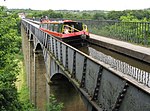Ellesmere Port railway station
DfT Category E stationsEllesmere PortFormer Birkenhead Railway stationsGrade II listed buildings in CheshireGrade II listed railway stations ... and 6 more
Northern franchise railway stationsPages with no open date in Infobox stationRailway stations in CheshireRailway stations in Great Britain opened in 1863Railway stations served by MerseyrailUse British English from February 2017

Ellesmere Port railway station is located in the town of Ellesmere Port, Cheshire, England. The station was an intermediate through station on the Hooton–Helsby line. Now all passenger services terminate at the station from both directions. It is both a terminus of the Wirral Line, a commuter rail system operated by Merseyrail and of Northern Trains services to Warrington Bank Quay. Departures and arrivals of Merseyrail services are on platform 1 with departures and arrivals to Warrington Bank Quay on platform 2.
Excerpt from the Wikipedia article Ellesmere Port railway station (License: CC BY-SA 3.0, Authors, Images).Ellesmere Port railway station
Station Road,
Geographical coordinates (GPS) Address Nearby Places Show on map
Geographical coordinates (GPS)
| Latitude | Longitude |
|---|---|
| N 53.2821 ° | E -2.8962 ° |
Address
Station Road
CH65 4BW , Wolverham
England, United Kingdom
Open on Google Maps








